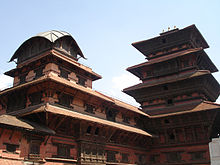Kathmandu Valley
| Kathmandu Valley | |
|---|---|
| Name as inscribed on the World Heritage List | |

|
|
| Location | Kathmandu Valley, Nepal |
| Type | Cultural |
| Criteria | iii, iv, vi |
| Reference | 121 |
| UNESCO region | Asia-Pacific |
| Coordinates | 27°42′14″N 85°18′32″E / 27.704°N 85.309°ECoordinates: 27°42′14″N 85°18′32″E / 27.704°N 85.309°E |
| Inscription history | |
| Inscription | 1979 (3rd Session) |
| Extensions | 2006 |
| Endangered | 2003–2007 |
The Kathmandu Valley (Nepali: काठमाडौं उपत्यका, Nepalbhasa:स्वनिगः, नेपाः गाः), located in Nepal, lies at the crossroads of ancient civilizations of Asia, and has at least 130 important monuments, including several pilgrimage sites for Hindus and Buddhists. There are seven World Heritage Sites within the valley.
Historically, the valley and adjoining areas made up a confederation known as the Nepal Mandala. Until the 15th century, Bhaktapur was its capital, when two other capitals, Kathmandu and Lalitpur (Patan), were established. After the annexation of the valley by the Gorkha Kingdom, and subsequent conversion of the valley as the capital of their empire, the designation of "Nepal" was extended to every land they conquered.
The Kathmandu Valley is the most developed and populated place in Nepal. The majority of offices and headquarters are located in the valley, making it the economic hub of Nepal. It is popular with tourists for its unique architecture, and rich culture that includes the highest number of jatras (street festivals) in Nepal. The valley itself was referred to as "Nepal Proper" by British historians.
Thousands of people died and tens of thousands of buildings and structures collapsed in Kathmandu Valley in the April 2015 Nepal earthquake.
The city of Kathmandu is named after a structure in Durbar Square called by the Sanskrit name Kāsṣtha mandapa "Wooden shelter". It was destroyed in the 2015 earthquake. This unique temple, also known as the Maru Sattal, was built in 1596 by King Lakshminarasimha Malla. The entire structure contained no iron nails or supports and was made entirely from wood. Legend has it that the timber used for this two-story pagoda was obtained from a single tree.
...
Wikipedia

